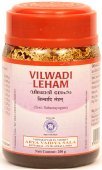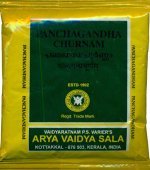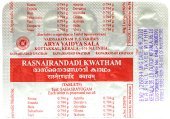Ghana, Ghanā, Ghāṇa, Ghāna: 46 definitions
Introduction:
Ghana means something in Buddhism, Pali, Hinduism, Sanskrit, Jainism, Prakrit, Marathi, Hindi, biology. If you want to know the exact meaning, history, etymology or English translation of this term then check out the descriptions on this page. Add your comment or reference to a book if you want to contribute to this summary article.
Images (photo gallery)
In Hinduism
Ayurveda (science of life)
Cikitsa (natural therapy and treatment for medical conditions)
Source: Wisdom Library: Ayurveda: CikitsaGhana (घन):—Another name for Mustā (Cyperus rotundus), a species of medicinal plant and used in the treatment of fever (jvara), as described in the Jvaracikitsā (or “the treatment of fever”) which is part of the 7th-century Mādhavacikitsā, a Sanskrit classical work on Āyurveda. The literal translation of Ghana is “killer” or “destroyer”, but in the Ayurvedic context, it refers to “compact”, “solid”, “thick” or “dense”.
Nighantu (Synonyms and Characteristics of Drugs and technical terms)
Source: WorldCat: Rāj nighaṇṭu1) Ghanā (घना) is another name for Māṣaparṇī, a medicinal plant identified with Teramnus labialis from the Fabaceae, or “pea family” of flowering plants, according to verse 3.30-33 of the 13th-century Raj Nighantu or Rājanighaṇṭu. The third chapter (guḍūcyādi-varga) of this book contains climbers and creepers (vīrudh). Together with the names Ghanā and Māṣaparṇī, there are a total of twenty-one Sanskrit synonyms identified for this plant.
2) Ghanā (घना) is also mentioned as a synonym for Rudrajaṭā, a medicinal plant identified with Aristolochia indica (Indian birthwort or duck flower) from the Aristolochiaceae or “birthwort family” of flowering plants, according to verse 3.79-81.
Kalpa (Formulas, Drug prescriptions and other Medicinal preparations)
Source: Shodhganga: Edition translation and critical study of yogasarasamgrahaGhana (घन) is another name for “Mustā” and is dealt with in the 15th-century Yogasārasaṅgraha (Yogasara-saṅgraha) by Vāsudeva: an unpublished Keralite work representing an Ayurvedic compendium of medicinal recipes. The Yogasārasaṃgraha [mentioning ghana] deals with entire recipes in the route of administration, and thus deals with the knowledge of pharmacy (bhaiṣajya-kalpanā) which is a branch of pharmacology (dravyaguṇa).
Agriculture (Krishi) and Vrikshayurveda (study of Plant life)
Source: Shodhganga: Drumavichitrikarnam—Plant mutagenesis in ancient IndiaGhana (घन) (identified with Cyperus hexastachys communis) is used in a recipe for producing fragrance (gandha-samutpatti), according to the Vṛkṣāyurveda by Sūrapāla (1000 CE): an encyclopedic work dealing with the study of trees and the principles of ancient Indian agriculture.—Accordingly: “An ordinary mango tree gets the good quality of a high class mango tree and puts forth fragrant blossom attracting the bees if it is smeared with the thick paste of Syzygium cumini, coral, Cyperus hexastachys communis [e.g., Ghana] and the roots of Vetiveria zizanioides and then sprinkled with the water from the same paste”.
Unclassified Ayurveda definitions
Source: archive.org: Vagbhata’s Ashtanga Hridaya Samhita (first 5 chapters)Ghana (घन) refers to the “thick” (e.g., water), as mentioned in verse 5.6-8 of the Aṣṭāṅgahṛdayasaṃhitā (Sūtrasthāna) by Vāgbhaṭa.—Accordingly, “[...] Not shall one drink (water that is) turbid [viz., āvila] and covered with mud, tape-grass, grass, and leaves, unseen by sun, moon, and wind, rained upon, thick [viz., ghana], heavy, [...]: (such water) one shall not drink”.
Source: Academia.edu: Ayurveda and PharmaceuticsGhana (Condense): Juice and other liquid medicinal substances are heated on slow fire to make into semisolid substance known as ghana. This form concentrates the medicinal ingredients and so the dosage is reduced. Sugar or jaggery is added to prepare a medicated confectionary, known as lehya. This form is very palatable and has longer shelf life.
Source: gurumukhi.ru: Ayurveda glossary of termsGhana (घन):—[ghanaṃ] Thick

Āyurveda (आयुर्वेद, ayurveda) is a branch of Indian science dealing with medicine, herbalism, taxology, anatomy, surgery, alchemy and related topics. Traditional practice of Āyurveda in ancient India dates back to at least the first millenium BC. Literature is commonly written in Sanskrit using various poetic metres.
Purana and Itihasa (epic history)
Source: archive.org: Shiva Purana - English Translation1) Ghana (घन) or Jalada refers to “clouds”, according to the Śivapurāṇa 2.2.22. Accordingly as Brahmā narrated to Nārada:—“[...] Once at the advent of clouds (jalada-āgama), Dakṣa’s daughter said to Śiva who was halting on the ridge of Kailāsa mountain. Satī said:—‘O lord of devas, O Śiva my dear husband, please hear my words and do accordingly, O bestower of honour. The most unbearable season of the advent of clouds (ghana-āgama) has arrived with clusters of clouds of diverse hues, and their music reverberating in the sky and the various quarters. The speedy gusts of wind scattering sprays of water mingled with nectarine drops from the Kadamba flowers captivate the heart as they blow’”.
2) Ghana (घन) or Ghanastana refers to “stout (breasts)”, according to the Śivapurāṇa 2.3.12.—Accordingly, after Himācala (i.e., Himālaya) brought his daughter (Pārvatī) before Śiva: “Then Śiva looked at her in the first flush of her youth. [...] Her two breasts resembling lotus-buds were stout [i.e., ghana], plump and firm. Her waist was slender and the curly locks of her hair shone well. Her feet resembled the land-lotus and were comely in appearance. She was competent to shake the minds of even the sages deeply engrossed in meditation, even at the very sight. She was a crest-jewel of all the maidens in the world”.
Source: Cologne Digital Sanskrit Dictionaries: The Purana IndexGhana (घन).—Three kinds described.*
- * Vāyu-purāṇa 51. 28-33.

The Purana (पुराण, purāṇas) refers to Sanskrit literature preserving ancient India’s vast cultural history, including historical legends, religious ceremonies, various arts and sciences. The eighteen mahapuranas total over 400,000 shlokas (metrical couplets) and date to at least several centuries BCE.
Natyashastra (theatrics and dramaturgy)
Source: Wisdom Library: Nāṭya-śāstra1) Ghana (घन) refers to “ solid instruments” (e.g., cymbals), according to the Nāṭyaśāstra 6.10 and chapter 28. It is part of the four groups of musical instruments (vādya).
2) Ghana (घन) refers to one of the four jātis, according to the Nāṭyaśāstra chapter 29. A jāti refers to a combination of the dhātus (roots). The four dhātus relate to different aspects of strokes in playing stringed instruments (tata). According to the Nāṭyaśāstra, “the ghana relates to the karaṇa-dhātus and depends on their quantity (lit. aggregate of long and short notes)”.
3) Ghana (घन) or Anugata refers to one of the three gatas: rules used in the playing of drums (puṣkara) [with reference to Mṛdaṅga, Paṇava and Dardura] according to the Nāṭyaśāstra chapter 33. Accordingly, “the anugata playing of drums, should begin with the sama-pāṇi or the avara-pāṇi, and it should have karaṇas produced by distinct strokes, and it should follow the song”.

Natyashastra (नाट्यशास्त्र, nāṭyaśāstra) refers to both the ancient Indian tradition (shastra) of performing arts, (natya—theatrics, drama, dance, music), as well as the name of a Sanskrit work dealing with these subjects. It also teaches the rules for composing Dramatic plays (nataka), construction and performance of Theater, and Poetic works (kavya).
Vyakarana (Sanskrit grammar)
Source: Wikisource: A dictionary of Sanskrit grammarGhana (घन).—A variety of the क्रमपाठ (kramapāṭha) or recital of the Vedic hymns to show the serial order of words there; one of the eight vikrtis of the padapātha.
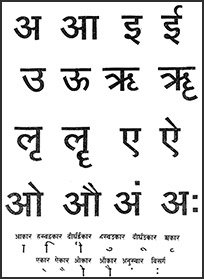
Vyakarana (व्याकरण, vyākaraṇa) refers to Sanskrit grammar and represents one of the six additional sciences (vedanga) to be studied along with the Vedas. Vyakarana concerns itself with the rules of Sanskrit grammar and linguistic analysis in order to establish the correct context of words and sentences.
Pancaratra (worship of Nārāyaṇa)
Source: eScholarship: Chapters 1-14 of the Hayasirsa PancaratraGhana (घन) refers to “one who is irascible”, representing an undesirable characteristic of an Ācārya, according to the 9th-century Hayaśīrṣa-pañcarātra Ādikāṇḍa chapter 3.—The Lord said:—“I will tell you about the Sthāpakas endowed with perverse qualities. He should not construct a temple with those who are avoided in this Tantra. [...] He should not despise Tantra or be devoted to plotting against others. He should not be born of adultery nor have the voice of a crow, be impotent, timid or irascible (ghana). [...] A god enshrined by any of these named above (viz., ghana), is in no manner a giver of fruit. If a building for Viṣṇu is made anywhere by these excluded types (viz., ghana) then that temple will not give rise to enjoyment and liberation and will yield no reward, of this there is no doubt”.
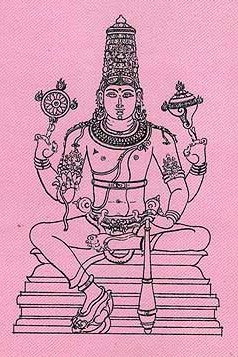
Pancaratra (पाञ्चरात्र, pāñcarātra) represents a tradition of Hinduism where Narayana is revered and worshipped. Closeley related to Vaishnavism, the Pancaratra literature includes various Agamas and tantras incorporating many Vaishnava philosophies.
Kavya (poetry)
Source: archive.org: Naisadhacarita of SriharsaGhana (घन) refers to a musical instrument (like bells and cymbals), and is mentioned in the Naiṣadha-carita 15.16.
Source: Brill: Śaivism and the Tantric Traditions (kavya)Ghana (घन) refers to “closely-set (bells)”, according to Bāṇa’s Kādambarī (p. 225).—Accordingly, while describing the shire of the Goddess Caṇḍikā, “[Then the portal to the sanctum sanctorum, a riot of colour and form:] She was being illuminated by the entrance, on which there were hanging cloths reddened by lamp-smoke, a row of bracelets made of peacock-throats festooned [over it], a garland of bells closely-set (ghana-ghaṇṭā-māla-bhārin) and pale with powdered flour-cakes, which supported two door-panels, [studded] with tin lion heads with thick, iron pins in their centres, barricaded with an ivory-rod bolt, carrying [what seemed to be] a necklace of sparkling bubbles that were mirrors oozing yellow, blue and red [light]”.

Kavya (काव्य, kavya) refers to Sanskrit poetry, a popular ancient Indian tradition of literature. There have been many Sanskrit poets over the ages, hailing from ancient India and beyond. This topic includes mahakavya, or ‘epic poetry’ and natya, or ‘dramatic poetry’.
Jyotisha (astronomy and astrology)
Source: Wisdom Library: Brihat Samhita by VarahamihiraGhana (घन) refers to “clouds”, according to the Bṛhatsaṃhitā (chapter 5), an encyclopedic Sanskrit work written by Varāhamihira mainly focusing on the science of ancient Indian astronomy astronomy (Jyotiṣa).—Accordingly, “Lunar and solar eclipses terminate in ten ways [...] If, within the said period [i.e., seven days], there should occur any meteoric fall, the ministers will die; if clouds of various hues should appear [i.e., ghana—nānāvarṇā ghanāśca], mankind will suffer from various fears; if clouds should begin to roar, there will be miscarriage of pregnancy; if lightning should appear, rulers and tusked animals will suffer. [...]”.
Source: Google Books: Studies in the History of the Exact Sciences (Astronomy)Ghana (घन) refers to “dense”, according to the Ghaṭikāyantraghaṭanāvidhi, an unpublished manuscript describing the ritual connected with the setting up of the water clock and its invocation.—Accordingly, “Salutation to Śrī Gaṇeśa. Now the method of setting up the water clock. A pure vessel, made of copper of ten palas in weight, of the shape of a hemisphere, measuring six aṅgulas from the bottom to the top, evenly dense [i.e., sama-ghana], in width twelve aṅgulas; pierced by a golden needle, made of one māṣa increased by three (tripacayā?). After measuring with that vessel, if it sinks sixty times (or, if it is filled in sixty palas of time), then it is a [proper] water clock”.

Jyotisha (ज्योतिष, jyotiṣa or jyotish) refers to ‘astronomy’ or “Vedic astrology” and represents the fifth of the six Vedangas (additional sciences to be studied along with the Vedas). Jyotisha concerns itself with the study and prediction of the movements of celestial bodies, in order to calculate the auspicious time for rituals and ceremonies.
Shaivism (Shaiva philosophy)
Source: Brill: Śaivism and the Tantric TraditionsGhana (घन) refers to “replete (with the Light of Consciousness)”, according to the Īśvarapratyabhijñāvimarśinī (KSTS vol. 65, 330).—Accordingly, “When one begins to contemplate ‘What is the reality of the body, etc.?’ [and subsequently realizes] “it is simply a form of awareness, replete with the Light of Consciousness (prakāśa-ghana),” then those [levels] from the Void to the body manifest as [they really are,] of one essence with Awareness, as if transmuted by its elixir. [...]”.

Shaiva (शैव, śaiva) or Shaivism (śaivism) represents a tradition of Hinduism worshiping Shiva as the supreme being. Closely related to Shaktism, Shaiva literature includes a range of scriptures, including Tantras, while the root of this tradition may be traced back to the ancient Vedas.
Ganitashastra (Mathematics and Algebra)
Source: archive.org: Hindu Mathematics1) Ghana (घन, “cube”) refers to one of the twenty operations (logistics) of pāṭīgaṇita (“science of calculation which requires the use of writing material—the board”), according to Pṛthudakasvāmī’s commentary on the Brāhmasphuṭasiddhānta by Brahmagupta, a Sanskrit treatise on ancient Indian mathematics (gaṇita-śāstra) and astronomy from the 7th century.—The term ghana occurs in all the mathematical works. It has been used in the geometrical as well as the arithmetical sense, Le., to denote the solid cube as well as the continued product of the same number taken three times. Another term for the cube is bṛnda, but it is seldom used.
Āryabhaṭa I in the Āryabhaṭīya: “The continued product of three equals and also the solid having twelve (equal) edges are called ghana”.
Śrīdhara in the Triśatikā, Mahāvīra in the Gaṇitasārasaṃgraha, Bhāskara II in the Līlāvatī: “The continued product of three equal numbers is ghana”.
Śrīdhara in the Triśatikā: “Set down the cube of the last; then set down at the next place 8 the square of the last multiplied by thrice the succeeding; then (at the next place) the product of the square of the succeeding and last multiplied by three; and then (at the next place) the cube of the succeeding”.
Brahmagupta in the Brāhmasphuṭasiddhānta: “Set down the cube of the last; then place at the next place from it, thrice the square of the last multiplied by the succeeding; then place at the next place thrice the square of the succeeding multiplied by the last; and (at the next place) the cube of the succeeding. This gives the cube (ghana)”
Mahāvīra in the Gaṇitasārasaṃgraha: “The cube of the last, the product of thrice its square and the remaining, the square of the remaining multiplied by thrice the last; placing of these, each one place before the other, constitutes here the process”.
Bhāskara II in the Līlāvatī: “Set down the cube of the last; then the square of the last multiplied by three times the succeeding; then the square of the succeeding multiplied by three times the last and then the cube of the succeeding; these placed so that there is difference of a place between one result and the next , 4 and added give the cube. The given number is distributed into portions according to places, one of which is taken for the last and the next as the first and in like manner repeatedly (if there be occasion). Or the same process may be begun from the first place of figures for finding the cube (ghana)”.
2) Ghana (वर्ग) or “cube” refers to the “third power”, according to the principles of Bījagaṇita (“algebra” or ‘science of calculation’).—The oldest Hindu terms for the power of a quantity, known or unknown, are found in the Uttarādhyayana-sūtra (c. 300 B.C. or earlier). In it the second power is called varga (square), the third power ghana (cube), the fourth power vargavarga (square-square), the sixth power ghanavarga (cube-square), and the twelfth power ghanavargavarga (cube-square-square), using the multiplicative instead of the additive principle. [...]
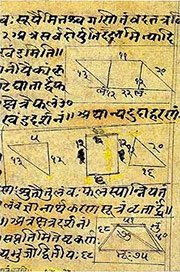
Ganitashastra (शिल्पशास्त्र, gaṇitaśāstra) refers to the ancient Indian science of mathematics, algebra, number theory, arithmetic, etc. Closely allied with astronomy, both were commonly taught and studied in universities, even since the 1st millennium BCE. Ganita-shastra also includes ritualistic math-books such as the Shulba-sutras.
Gitashastra (science of music)
Source: Shodhganga: Elements of Art and Architecture in the Trtiyakhanda of the Visnudharmottarapurana (gita)Ghana (घन) refers to “those instruments which are made with some solid metals” and represents one of the four kinds of Instrumental Music, produced by an instrument (ātodya).—In the Kalānidhi commentary of Kallinātha on Saṃgītaratnākara, the word ghana is explained as mūrti (i.e., material element). It can be said that as the word ghana denotes compactor solid, this kind of Music instruments are made with some solid metals. According to the Saṃgītaratnākara, the ghana kind of instruments make sound when they strike together. The Viṣṇudharmottarapurāṇa mentions tāla i.e., cymbal as the example of ghana kind of instrument.
The Saṃgītaratnākara also mentions the following as examples of ghana kind of instrument:—
- tāla,
- kāṃsya,
- ghaṇṭā,
- kṣudraghaṇṭikā,
- jayaghaṇṭā,
- kamrā,
- śuktipaṭṭa etc.
Gitashastra (गीतशास्त्र, gītaśāstra) refers to the ancient Indian science of Music (gita or samgita), which is traditionally divided in Vocal music, Instrumental music and Dance (under the jurisdiction of music). The different elements and technical terms are explained in a wide range of (often Sanskrit) literature.
In Buddhism
Theravada (major branch of Buddhism)
Source: Journey to Nibbana: Patthana Dhamaghana means related to nose,
Theravāda is a major branch of Buddhism having the the Pali canon (tipitaka) as their canonical literature, which includes the vinaya-pitaka (monastic rules), the sutta-pitaka (Buddhist sermons) and the abhidhamma-pitaka (philosophy and psychology).
Tibetan Buddhism (Vajrayana or tantric Buddhism)
Source: Wisdomlib Libary: VajrayoginiGhana (घन) is the name of a cloud (megha) associated with Aṭṭaṭṭahāsa: the north-eastern cremation ground (śmaśāna) according to the Vajravārāhī-sādhana by Umāpatideva as found in te 12th century Guhyasamayasādhanamālā. As a part of this sādhana, the practicioner is to visualize a suitable dwelling place for the goddess inside the circle of protection which takes the form of eight cremation grounds.
These clouds (e.g., Ghana) are known as cloud-kings (megharāja) and have names that are associated with the loud noises of thunderclouds and the noise of rain, according to the Guhyasamayasādhanamālā 11.77. Their presence in the cremation grounds may be connected with the nāgas, for they are known to be responsible for the rain.
Source: academia.edu: The Structure and Meanings of the Heruka MaṇḍalaGhana (घन) refers to one of the eight cloud king (meghendra) of the Guṇacakra, according to the 10th century Ḍākārṇava chapter 15. Accordingly, the guṇacakra refers to one of the four divisions of the sahaja-puṭa (‘innate layer’), situated within the padma (lotus) in the middle of the Herukamaṇḍala. Ghana is associated with the charnel grounds (śmaśāna) named Aṭṭahāsa; with the tree (vṛkṣa) named Vaṭa; with the direction-guardians (dikpāla) named Īśāna and with the serpent king (nāgendra) named Mahāpadma.
Source: OSU Press: Cakrasamvara SamadhiGhana (घन) refers to a “striker”, according to the Cakrasaṃvara Samādhi [i.e., Cakrasamvara Meditation] ritual often performed in combination with the Cakrasaṃvara Samādhi, which refers to the primary pūjā and sādhanā practice of Newah Mahāyāna-Vajrayāna Buddhists in Nepal.—Accordingly, “A red twilight, producing a sharp essence, an edge as bright as seven suns, A knife killing all enemies, a gleaming immortal striker (sphurat-amṛta-ghanā) held by the right arm”.

Tibetan Buddhism includes schools such as Nyingma, Kadampa, Kagyu and Gelug. Their primary canon of literature is divided in two broad categories: The Kangyur, which consists of Buddha’s words, and the Tengyur, which includes commentaries from various sources. Esotericism and tantra techniques (vajrayāna) are collected indepently.
Mahayana (major branch of Buddhism)
Source: Wisdom Library: Maha Prajnaparamita SastraGhana (घन) refers to one of the embryonic stages according to the 2nd century Mahāprajñāpāramitāśāstra (chapter VII).—“According to some, at the moment of reincarnation (pratisaṃdhi), all beings have a disturbed mind; but since the Bodhisattva has no loss of mindfulness, it is said that he enters his mother’s womb with an undisturbed mind. When he is in the stage of the K’ie na (ghana), he knows that he is in the ghana stage, i.e., three weeks after conception, he resembles frozen cream”.

Mahayana (महायान, mahāyāna) is a major branch of Buddhism focusing on the path of a Bodhisattva (spiritual aspirants/ enlightened beings). Extant literature is vast and primarely composed in the Sanskrit language. There are many sūtras of which some of the earliest are the various Prajñāpāramitā sūtras.
In Jainism
General definition (in Jainism)
Source: Encyclopedia of Jainism: Tattvartha Sutra 3: The Lower and middle worldsGhana (घन) means “thick” or “humid” and refers to a type of strata or cushion supporting the lands (bhumī) of the underworld, according to the 2nd-century Tattvārthasūtra 3.1. There are seven lands existing in the downward order (one below the other) with Ratnaprabhā being the topmost supported by the cushions of humid atmosphere (ghana), dense air /water (ambu), which rests in a ring of thin /rarified air (vāta) resting in space (ākāśa).
Source: Encyclopedia of Jainism: Tattvartha Sutra 5: The category of the non-livingGhana (घन) refers to one of the four types of contrived sound (prāyogika) according to the 2nd-century Tattvārthasūtra 5.24.—What is ghana sound? Sound produced by metallic musical instruments e.g. bell in the temples, cymbals etc.
Source: The University of Sydney: A study of the Twelve ReflectionsGhana (घन) refers to “clouds”, according to the 11th century Jñānārṇava, a treatise on Jain Yoga in roughly 2200 Sanskrit verses composed by Śubhacandra.—Accordingly, “Connections with pleasing sense objects, whose impressions are full of deceit like dreams, perish immediately. Families, armies, empires, decorations and wealth are asserted by the great seers as acting like a series of clouds (ghana-mālā-anukārin)”.
Synonyms: Megha, Jalada, Parjanya.
Source: academia.edu: The Original Paṇhavāyaraṇa/Praśnavyākaraṇa DiscoveredGhana (घन) refers to “solidness” (i.e., solid density), as taught in the Paṇhavāgaraṇa (Sanskrit: Praśnavyākaraṇa): the tenth Anga of the Jain canon which deals with the prophetic explanation of queries regarding divination.—The Praśnavyākaraṇa deals with the praśnavidyā in a rather complex way. It is divided into at least 33 short chapters [e.g., ghana-chidra-vibhāga-prakaraṇa], some of which are further divided into sub-chapters. Some contents of the text, mainly those related with articulation and pronunciation can have significance far beyond the scope of the praśnavidyā.

Jainism is an Indian religion of Dharma whose doctrine revolves around harmlessness (ahimsa) towards every living being. The two major branches (Digambara and Svetambara) of Jainism stimulate self-control (or, shramana, ‘self-reliance’) and spiritual development through a path of peace for the soul to progess to the ultimate goal.
Biology (plants and animals)
Source: Google Books: CRC World Dictionary (Regional names)1) Ghana in India is the name of a plant defined with Teramnus labialis in various botanical sources. This page contains potential references in Ayurveda, modern medicine, and other folk traditions or local practices It has the synonym Glycine warreensis Dalzell (among others).
2) Ghana in Mali is also identified with Vetiveria nigritana It has the synonym Chrysopogon nigritanus (Benth.) Veldkamp (etc.).
3) Ghana in Tanzania is also identified with Mimusops kummel It has the synonym Binectaria fragrans (Baker) Kuntze (etc.).
Example references for further research on medicinal uses or toxicity (see latin names for full list):
· Synopsis Plantarum (Persoon) (1807)
· Revisio Generum Plantarum (1891)
· Linnaea (1840)
· Systema Vegetabilium (1826)
· Encyclopédie Méthodique, Botanique (1788)
· Commentariorum de Plantis Africae Australioris (1836)
If you are looking for specific details regarding Ghana, for example chemical composition, diet and recipes, extract dosage, health benefits, pregnancy safety, side effects, have a look at these references.

This sections includes definitions from the five kingdoms of living things: Animals, Plants, Fungi, Protists and Monera. It will include both the official binomial nomenclature (scientific names usually in Latin) as well as regional spellings and variants.
Languages of India and abroad
Pali-English dictionary
Source: BuddhaSasana: Concise Pali-English Dictionaryghana : (adj.) thick; solid; dense; compact. (nt.), a club; a hammer; a musical instrument played by striking. (m.), a cloud.
-- or --
ghāṇa : (nt.) the nose.
Source: Sutta: The Pali Text Society's Pali-English Dictionary1) Ghana, 2 (Vedic ghana to hanti (ghanti, cp. ghātayati), *gǔhen “strike, ” cp. Gr. qei/nw, fόnos, Lat. of-fendo, Ags. gud, Ohg. gundea) a club, a stick, a hammer; in ayo° an iron club VvA.20. Also coll. term for a musical instrument played by striking, as cymbal, tambourine, etc. VvA.37. (Page 257)
2) Ghana, 1 (Vedic ghana, cp. Gr. eu)qhnήs?) (a) (adj.) solid, compact, massive; dense, thick; in eka° of one solid mass (of sela, rock) Vin.I, 185=Dh.81=Th.1, 643= Miln.386; A.III, 378, cp. ghanasela-pabbata DhA.I, 74.—gh. paṃsu J.I, 264, paṭhavī (solid ground) J.I, 74; PvA.75; palāsa (foliage) PvA.113; buddharasmiyo J.I, 12; °maṃsa solid, pure flesh DhA.I, 80; °sāṭaka (thick cloth) J.I, 292; °sañchanna (thickly covered) PvA.258; °suvaṇṇakoṭṭima DhA.IV, 135; abbha° a thick cloud Sn.348 (cp. SnA 348).—(b) (m.) the fœtus at a certain stage (the last before birth & the 4th in the enum. of the foll. stages: kalala, abbuda, pesī, gh.) S.I, 206; J.IV, 496; Miln.40; Vism.236. The latter meaning is semantically to be explained as “swelling” & to be compared with Gr. bru/w to swell and e(/mbruon=embryo (the gravid uterus). (Page 257)
— or —
Ghāna, (nt.) (Sk. ghrāṇa to ghrā, see ghāyati. On n for ṇ cp. Trenckner, Notes, p. 81) the nose; usually in its function as organ of smell=sense of smell (either in phrase ghānena gandhaṃ ghāyati: to smell an odour by means of the nose; or in ghana-viññeyyā gandhā: odours which are sensed by the nose). In the enum. of the senses gh. is always mentioned in the 3rd place (after cakkhu & sota, eye & ear); see under rūpa. In this connection: Vin.I, 34; D.I, 21, 245; III, 102, 244 sq.; S.I, 115; M.I, 112, 191; II, 42; Dh.360; Pug.20; Miln.270; Vism.444 sq. (with definition).—In other connections: Pv.II, 24 (ghāna-chinna, one whose nose is cut off).

Pali is the language of the Tipiṭaka, which is the sacred canon of Theravāda Buddhism and contains much of the Buddha’s speech. Closeley related to Sanskrit, both languages are used interchangeably between religions.
Marathi-English dictionary
Source: DDSA: The Molesworth Marathi and English Dictionaryghaṇa (घण).—m (S or ghana) A sledge-hammer. Pr. hiṛyā- cī parīkṣā ghaṇāvāñcūna hōta nāhīṃ. Pr. ghaṇācē ghāva sōsīla tō hirā.
--- OR ---
ghaṇa (घण).—a (ghana S) Thick--liquid substances: copious and heavy--rain: of close texture--cloth: dense, close, impervious--a wood: thick or deep--a plank: crowded--an assemblage. 2 Doggedly silent.
--- OR ---
ghaṇā (घणा).—m (ghaṇa) An extraordinarily large ghaṇa or sledge-hammer. ghaṇyāghāyīṃ Under the animated sounding of the ghaṇā. Used with nāndaṇēṃ-asaṇēṃ &c. (To have trinkets always under the hammer.) To be very rich.
--- OR ---
ghana (घन).—m (S) A cloud. 2 The cube of a number. 3 In geometry. A cube or a solid. 4 A sledgehammer. 5 n A general name for Musical instruments of brass or other composite metal which are to be beaten or struck; as karatāla, ṭāḷa, jhāñja, jhēṅgaṭa &c.: also a bell or gong.
--- OR ---
ghana (घन).—a (S) Coarse, close, dense, solid, compact, firm. See the derived and commoner word ghaṇa.
--- OR ---
ghāṇa (घाण).—f An offensive smell; stench, fœtor. 2 Any thing nauseous and disgusting, offending the smell or sight; any nastiness, mess, slop, litter, rubbish. Ex. āṅgaṇānta ghāṇa paḍalī tī kāḍhūna ṭāka. 3 A term of reviling;--used to persons and things. Ex. hā dhōtarajōḍā āṭha hāta hī ghāṇa malā nakō. (Agreeing with stinking stuff, stinking fellow.) 4 Confusion, disorder, derangement (of an account, of affairs): plight, pickle, mess (of persons or things). 5 The wheelrut of a lime-grinding mill. 6 Smell, scent, odor gen. Ex. javādīcī ghāṇa lasaṇāsavēṃ gēlī || svādā nāhīṃ ālī kusaṅgatī ||. 7 Used as an interjection, expressing vexation, irritation, impatience. ghāṇa yēṇēṃ g. of o. To stink in one's nostrils. ghāṇī- cā (Having the stench or the flavor of.) Pertaining to or connected with in some remote way.
--- OR ---
ghāṇā (घाणा).—m An oil-mill. 2 The block in which the lāṭa or roller moves. 3 Materials thrown into the mill at one time, the charge. Hence fig. The quantity of rice, gram &c. put at once into the pounding mortar or parching pan; of drugs, spiceries &c. into the mortar; of materials gen. to be ground, pounded, bruised, levigated, mashed. 4 The heap of grain which, on Makar Sankranti, the mistress of the house places on the pounding mortar; to be given to some Brahman. 5 A sugarcane-press. 6 The making (at marriages or thread-investitures) of a ghāṇā (i. e. a duraḍī full of rice) and the pounding and singing &c. by the assembled gossips. v bhara, ghāla. 7 The wheelrut of a lime-grinding mill. ghāṇā karaṇēṃ g. of o. To harass or worry (persons, animals): to rumple, discompose, disorder (clothes, papers &c.) ghāṇyānta ghālaṇēṃ To cast into a troublous condition. ghāṇyāntūna piḷaṇēṃ or kāḍhaṇēṃ To squeeze and crush; to destroy the strength, substance, marrow of, lit. fig.
Source: DDSA: The Aryabhusan school dictionary, Marathi-Englishghaṇa (घण).—m A sledge-hammer. a Thick.
--- OR ---
ghana (घन).—m A cloud. The cube of a number; a cube. A sledge-hammer. a Thick.
--- OR ---
ghāṇa (घाण).—f An offensives smell; stench, fœtor. Any thing nauseous and disgusting. A term of reviling-used to persons and things. Disorder, derangement (of an account, of affairs): plight, pickle, mess (of persons or things).
--- OR ---
ghāṇā (घाणा).—m An oil-mill. Materials thrown into the mill at one time, the charge. A sugarcane-press. ghāṇyāta ghālaṇēṃ To cast into a troublous condition. ghāṇyātūna piḷaṇēṃ or kāḍhaṇēṃ To squeeze and erush.
--- OR ---
ghāṇā (घाणा).—f A lime-mill.
Marathi is an Indo-European language having over 70 million native speakers people in (predominantly) Maharashtra India. Marathi, like many other Indo-Aryan languages, evolved from early forms of Prakrit, which itself is a subset of Sanskrit, one of the most ancient languages of the world.
Sanskrit dictionary
Source: DDSA: The practical Sanskrit-English dictionaryGhana (घन).—a. [in mūrtau ap ghanādeśaśca Tv.]
1) Compact, firm, hard, solid; संजातश्च घनाघनः (saṃjātaśca ghanāghanaḥ) Mālatīmādhava (Bombay) 9.39.; नासा घनास्थिका (nāsā ghanāsthikā) Y.3.89; R.11.18.
2) Thick, close, dense; घनविरलभावः (ghanaviralabhāvaḥ) Uttararāmacarita 2.27; R.8.91; Amaruśataka 59.
3) Thick-set, full, fully developed (as breasts); घटयति सुघने कुचयुगगगने मृगमदरुचि रूषिते (ghaṭayati sughane kucayugagagane mṛgamadaruci rūṣite) Gītagovinda 7; अगुरु-चतुष्कं भवति गुरू द्वौ घनकुचयुग्मे शशिवदनाऽसौ (aguru-catuṣkaṃ bhavati gurū dvau ghanakucayugme śaśivadanā'sau) Śrut.8; Bhartṛhari 1.8; Amaruśataka 31.
4) Deep (as sound); दधानः सौधानामलघुषु निकुञ्जेषु घनताम् (dadhānaḥ saudhānāmalaghuṣu nikuñjeṣu ghanatām) Mālatīmādhava (Bombay) 2.12; Mu.1.21.
5) Uninterrupted, permanent.
6) Impenetrable.
7) Great, excessive, violent.
8) Complete; अभ्यङ्गभङ्ग्या पापस्य न्यस्तं घनमपश्यतः (abhyaṅgabhaṅgyā pāpasya nyastaṃ ghanamapaśyataḥ) Kathāsaritsāgara 4.53.
9) Auspicious, fortunate.
1) Coarse, gross.
11) Engrossed by, full or replete with; मा ते मलीमसविकारघना मतिर्भूत् (mā te malīmasavikāraghanā matirbhūt) Mālatīmādhava (Bombay) 1.32; निर्वृति° (nirvṛti°) Uttararāmacarita 6.11.
[Ghanaḥ]—1) A cloud; घनोदयः प्राक् तदनन्तरं पयः (ghanodayaḥ prāk tadanantaraṃ payaḥ) Ś.7.3; घनरुचिरकलापो निःसपत्नोऽस्य जातः (ghanarucirakalāpo niḥsapatno'sya jātaḥ) V.4.22.
2) An iron club, a mace; प्रतिजघान घनैरिव मुष्टिभिः (pratijaghāna ghanairiva muṣṭibhiḥ) Kirātārjunīya 18.1.
3) The body.
4) The cube of a number (in math.).
5) Extension, diffusion.
6) A collection, multitude, quantity, mass, assemblage.
7) Talc.
8) Phlegm.
9) Any compact mass or substance.
1) Hardness, firmness.
11) A particular manner of reciting Vedic texts : thus the padas नमः रुद्रेभ्यः ये (namaḥ rudrebhyaḥ ye) repeated in this manner would stand thus :-नमो रुद्रेभ्यो रुद्रेभ्यो नमो नमो रुद्रेभ्यो ये ये रुद्रेभ्यो नमो नमो रुद्रेभ्यो ये (namo rudrebhyo rudrebhyo namo namo rudrebhyo ye ye rudrebhyo namo namo rudrebhyo ye).
[Ghanam]—1 A cymbal, a bell, a gong.
2) Iron.
3) Tin.
4) Skin, rind, bark.
5) A mode of dancing; (neither quick nor slow). ind. closely; घटयति घनं कण्ठा- श्लेषे रसान्न पयोधरौ (ghaṭayati ghanaṃ kaṇṭhā- śleṣe rasānna payodharau) Ratnāvalī 3.9.
Source: Cologne Digital Sanskrit Dictionaries: Shabda-Sagara Sanskrit-English DictionaryGhana (घन).—mfn.
(-naḥ-nā-naṃ) 1. Material, solid. 2. Coarse, gross. 3. Compact. 4. Hard, firm. 5. Full, plum. 6. Impenetrable. 7. Vicid, thick, inspissated. 8. Deep, (as sound) 9. Very, much. 10. Auspicious, fortunate. 11. Permanent, eternal. m.
(-naḥ) 1. A cloud. 2. An iron club. 3. The body. 4. A fragrant grass, (Cyperus rotundus.) 5. A number, an assemblage or quantity. 6. Extension, diffusion. 7. Hardness. 8. Solidity, substance. matter. 9. The cube of a number, (in arithmetic.) 10. A solid, (in geometry.) 11. Phlegm. 12. Talc. n.
(-naṃ) 1. A cymbal, a bell, a Gong, &c. any brazen or composite metallic instrument, which is struck as a clock, &c. 2. A mode of dancing, neither quick nor slow. 3. Iron. 4. Skin, rind, bark, &c. E. han to strike or be struck, affix ap and ha changed to gha.
Source: Cologne Digital Sanskrit Dictionaries: Benfey Sanskrit-English DictionaryGhana (घन).—i. e. han + a, I. adj., f. nā, 1. Firm, hard, [Bhartṛhari, (ed. Bohlen.)] 1, 17. 2. Without interstices, [Suśruta] 1, 29, 8. 3. Uninterrupted, [Pañcatantra] iii. [distich] 237. 4. Dense, [Pañcatantra] iii. [distich] 188; 129, 8. 5. As latter part of a compound adj., sometimes Full, [Raghuvaṃśa, (ed. Stenzler.)] 8, 90. 6. Dusk, [Bhāgavata-Purāṇa, (ed. Burnouf.)] 4, 5, 3. 7. Deep (as a sound), Mahābhārata 1, 6680; [Rājataraṅgiṇī] 5, 377. 8. Whole, [Upakośa] 24. Ii. m. 1. A solid mass, substance, [Vedāntasāra, (in my Chrestomathy.)] in
Ghana (घन).—[adjective] slaying, striking; compact, solid, firm, tight ([neuter] [adverb]); dark, deep (sound); uninterrupted, whole, entire; full of (—°). [masculine] slaughter, slayer; mace, club, hammer; compact mass, cloud; nothing but (—°).
Source: Cologne Digital Sanskrit Dictionaries: Monier-Williams Sanskrit-English Dictionary1) Ghana (घन):—mf(ā)n. (√han) a striker, killer, destroyer, [Ṛg-veda i, 4, 8; iii, 49, 1; iv, 38, 1; viii, 96, 18]
2) compact, solid, material, hard, firm, dense, [i, 8, 3] (ghanā for nam ā), [Suśruta] etc.
3) coarse, gross
4) viscid, thick, inspissated, [Suśruta; Bhartṛhari; Kathāsaritsāgara xxiv, 93]
5) full of (in [compound]), densely filled with (in [compound]), [Mahābhārata i, xiii; Raghuvaṃśa viii, 90; Ratnāvalī iv, 2]
6) uninterrupted, [Pañcatantra iii, 14, 11]
7) dark (cf. -śyāma), [Bhāgavata-purāṇa iv, 5, 3]
8) deep (as sound; colour), [Mahābhārata i, 6680; Varāha-mihira’s Bṛhat-saṃhitā xliii, 19]
9) complete, all, [Kathāsaritsāgara iv, 53]
10) auspicious, fortunate, [Horace H. Wilson]
11) m. (= φόνος) slaying, [Ṛg-veda vi, 26, 8]
12) an iron club, mace, weapon shaped like a hammer, [i, 33, 4; 36, 16; 63, 5; ix, 97, 16; Atharva-veda x, 4, 9]
13) any compact mass or substance (generally ifc.), [Śatapatha-brāhmaṇa xiv etc.] (said of the foetus in the 2nd month, [Nirukta, by Yāska xiv, 6; Laghujātaka, by Varāha-mihira iii, 4])
14) ifc. mere, nothing but (e.g. vijñāna-ghana, ‘nothing but intuition’ [Śatapatha-brāhmaṇa xiv]), [Māṇḍūkya-upaniṣad, 12 mantra 5; Praśna-upaniṣad v, 5; Bhāgavata-purāṇa viii f.] (cf. ambu-, ayo-)
15) a collection, multitude, mass, quantity, [Horace H. Wilson]
16) vulgar people, [Subhāṣitāvali]
17) a cloud, [Mahābhārata] etc. (ifc. f(ā). , [Harivaṃśa 2660])
18) talc, [cf. Lexicographers, esp. such as amarasiṃha, halāyudha, hemacandra, etc.]
19) the bulbous root of Cyperus Hexastachys communis, [Suśruta vi]
20) a peculiar form of a temple, [Hemādri’s Caturvarga-cintāmaṇi ii, 1, 389]
21) a particular method of reciting the [Ṛg-veda] and Yajur-veda (cf. [Religious Thought and Life in India p.409])
22) the cube (of a number), solid body (in [geometry]), [Laghujātaka, by Varāha-mihira; Sūryasiddhānta]
23) phlegm (kapha), [cf. Lexicographers, esp. such as amarasiṃha, halāyudha, hemacandra, etc.]
24) the body, [cf. Lexicographers, esp. such as amarasiṃha, halāyudha, hemacandra, etc.]
25) extension, diffusion, [Horace H. Wilson]
26) n. any brazen or metallic instrument or plate which is struck (cymbal, bell, gong, etc.), [Harivaṃśa 8688]
27) iron, [cf. Lexicographers, esp. such as amarasiṃha, halāyudha, hemacandra, etc.]
28) tin, [cf. Lexicographers, esp. such as amarasiṃha, halāyudha, hemacandra, etc.]
29) a mode of dancing (neither quick nor slow), [cf. Lexicographers, esp. such as amarasiṃha, halāyudha, hemacandra, etc.]
30) darkness, [cf. Lexicographers, esp. such as amarasiṃha, halāyudha, hemacandra, etc.]
31) n. (√dhvan, to sound) deep, [Rājataraṅgiṇī v, 377]
32) very much, [Horace H. Wilson]
33) Ghanā (घना):—[from ghana] f. Name of a stringed instrument
34) [v.s. ...] Glycine debilis, [cf. Lexicographers, esp. such as amarasiṃha, halāyudha, hemacandra, etc.]
35) [v.s. ...] a kind of creeper, [cf. Lexicographers, esp. such as amarasiṃha, halāyudha, hemacandra, etc.]
Source: Cologne Digital Sanskrit Dictionaries: Yates Sanskrit-English Dictionary1) Ghaṇa (घण):—(da, u, ña) ghaṇoti ṇute 8. c. To shine.
2) Ghana (घन):—(naḥ) 1. m. A cloud; an assemblage. 1. m. A cymbal, a bell; iron; skin; a solid. a. Solid, thick, hard; deep-toned.
Source: DDSA: Paia-sadda-mahannavo; a comprehensive Prakrit Hindi dictionary (S)Ghana (घन) in the Sanskrit language is related to the Prakrit words: Ghaṇa, Ghaṇā.
[Sanskrit to German]
Sanskrit, also spelled संस्कृतम् (saṃskṛtam), is an ancient language of India commonly seen as the grandmother of the Indo-European language family (even English!). Closely allied with Prakrit and Pali, Sanskrit is more exhaustive in both grammar and terms and has the most extensive collection of literature in the world, greatly surpassing its sister-languages Greek and Latin.
Hindi dictionary
Source: DDSA: A practical Hindi-English dictionary1) Ghana (घन) [Also spelled ghan]:—(nm) a hammer, sledge-hammer; cube; cloud; (a) dense; solid; ~[ghora] very dense; terrible, profound; ~[cakkara] a blockhead; dolt; ~[phala] cube; ~[mūla] cube-root; —[kī coṭa] a heavy shattering stroke, hammer stroke.
2) Ghanā (घना):—(a) dense, thick; intensive (as cultivation); compact; ~[pana] denseness; compactness.
3) Ghāna (घान) [Also spelled ghan]:—(nm) a lot; quantity of oilseed, wheat, etc. ground or pressed in one lot; things cooked or fried in one lot.
...
Prakrit-English dictionary
Source: DDSA: Paia-sadda-mahannavo; a comprehensive Prakrit Hindi dictionary1) Ghaṇa (घण) in the Prakrit language is related to the Sanskrit word: Ghana.
2) Ghaṇā (घणा) also relates to the Sanskrit word: Ghanā.
3) Ghaṇā (घणा) also relates to the Sanskrit word: Ghṛṇā.
4) Ghāṇa (घाण) also relates to the Sanskrit word: Ghrāṇa.
Prakrit is an ancient language closely associated with both Pali and Sanskrit. Jain literature is often composed in this language or sub-dialects, such as the Agamas and their commentaries which are written in Ardhamagadhi and Maharashtri Prakrit. The earliest extant texts can be dated to as early as the 4th century BCE although core portions might be older.
Kannada-English dictionary
Source: Alar: Kannada-English corpusGhana (ಘನ):—
1) [adjective] having weight; hard to lift or move because of great weight; weighty.
2) [adjective] (said of persons) of great significance or importance; prominent; outstanding; remarkable.
3) [adjective] being too much or too great; excessive.
4) [adjective] crowded; dense.
5) [adjective] tending to keep its form rather than to flow or spread out like a liquid or gas; solid.
6) [adjective] having the three dimensions of length, breadth, and thickness; solid.
7) [adjective] lacking no component part; full; whole; entire; complete.
8) [adjective] low or deep in pitch; dignified and solemn (said of voice).
--- OR ---
Ghana (ಘನ):—
1) [noun] that which is excellent, eminent; a thing of exceptional merit or virtue.
2) [noun] a solid a) a substance that is solid, not a liquid or gas; b) an object or figure having or represented as having length, breadth, and thickness.
3) [noun] a visible mass of tiny, condensed water droplets or ice crystals suspended in the atmosphere; a cloud.
4) [noun] any of the musical instrument made of bronze (as a cymbal, bell, gong, etc.).
5) [noun] the resonant tone produced as by a metallic disk, cymbal, etc. when struck.
6) [noun] a hammer-like weapon; a kind of mace.
7) [noun] any bulky or quite large object.
8) [noun] a particular manner of reciting the vedic hymns, in which each or most of the words are repeated many times in different combinations.
9) [noun] the quality of being wise, large-hearted, noble, etc.; nobility.
10) [noun] 'a ductile, malleable, silver-white metallic element, scarcely known in a pure condition, but much used in its crude or impure carbon-containing forms for making tools, implements, machinery, etc. (symbol: Fe); iron.'11) [noun] 'a low-melting, malleable, ductile metallic element resembling in colour and lustre, used in plating and in making alloys, foil, and soft solders, etc. (symbol: Sn.) tin.'12) [noun] the absence of light; darkness.
13) [noun] a group of large number of people.
14) [noun] the bulbous root of the plant Cyperus rotundus ( = C. hexastachyus) of Ceperaceae family; a kind of sedge.
15) [noun] the state or quality of being strong; strength.
16) [noun] that which is old, hence useless.
17) [noun] a transparent, odourless, tasteless liquid, a compound of hydrogen and oxygen, (symbol H2O); water.
18) [noun] the state or fact of being ignorant; lack of knowledge, learning, wisdom, etc19) [noun] the outer cover of the body (the skin) or of a tree (bark).
20) [noun] a hostile encounter or engagement between opposing military forces; a battle.
21) [noun] the quality or condition of being large.
22) [noun] (dance) a gait that is neither too fast nor too slow.
23) [noun] (vīr.) the Absolute; Paraśiva.
24) [noun] the amount of space occupied in three dimensions (which is mathematically got by multiplying the length, breadth and height); volume.
25) [noun] the product obtained by multiplying a given number or quantity by its square (as 27 = 3 x 3 x 3); the cube of a figure.
26) [noun] a solid with six equal, square sides; a cube.
27) [noun] seriousness, importance or gravity of a situation, deed.
--- OR ---
Ghāṇa (ಘಾಣ):—[noun] a press or mill used to extract juice from sugarcane or oil from oil seeds.
--- OR ---
Ghāṇa (ಘಾಣ):—[adjective] that stinks; offensively smelling; stinking.
Kannada is a Dravidian language (as opposed to the Indo-European language family) mainly spoken in the southwestern region of India.
Nepali dictionary
Source: unoes: Nepali-English Dictionary1) Ghana (घन):—n. 1. cloud; 2. heavy hammer/club; 3. Math. (of a number) cube; 4.solidity; hardness; heaviness; 5. a method of reciting the Vedas; 6. a cymbal; bell;
2) Ghanā (घना):—adj. thick; dense; compact; 2. much; abundant;
Nepali is the primary language of the Nepalese people counting almost 20 million native speakers. The country of Nepal is situated in the Himalaya mountain range to the north of India.
See also (Relevant definitions)
Starts with (+220): Ghana shringi, Ghana-yenem, Ghanaadi, Ghanaalo, Ghanaaulo, Ghanabha, Ghanabhitti, Ghanabhoga, Ghanabhumadhya, Ghanacakkara, Ghanacakra, Ghanacaya, Ghanacchada, Ghanacchidra, Ghanacchidravibhaga, Ghanachada, Ghanachaya, Ghanacitra, Ghanadanta, Ghanadantaka.
Ends with (+136): Abhilanghana, Abhraghana, Aghana, Aghananaghana, Ajnalamghana, Alamghana, Alanghana, Ambughana, Amritaghana, Anandacidghana, Anandaghana, Antarghana, Anughana, Apaghana, Ardhaghana, Ashtaghana, Ashvajaghana, Atapalanghana, Atighana, Atilamghana.
Full-text (+526): Praghana, Ghanashraya, Ghanatola, Ghanavallika, Ghanakapha, Ghanatyaya, Ghanambu, Ghananabhi, Payoghana, Ghanashyama, Shrighana, Ghanavata, Durghana, Ghanamaya, Ghanasara, Ghanapallava, Ghanavithi, Ghanasvana, Ghanavartman, Aghana.
Relevant text
Search found 101 books and stories containing Ghana, Ghaṇā, Ghaṇa, Ghanā, Ghāṇa, Ghāna, Ghāṇā, Ghanaa; (plurals include: Ghanas, Ghaṇās, Ghaṇas, Ghanās, Ghāṇas, Ghānas, Ghāṇās, Ghanaas). You can also click to the full overview containing English textual excerpts. Below are direct links for the most relevant articles:
Garga Samhita (English) (by Danavir Goswami)
Verses 5.5.41-42 < [Chapter 5 - Śrī Kṛṣṇa’s Entrance Into Mathurā]
Verse 5.20.47 < [Chapter 20 - The Liberation of Ṛbhu Muni During the Rāsa-dance Festival]
Verse 5.20.15 < [Chapter 20 - The Liberation of Ṛbhu Muni During the Rāsa-dance Festival]
The backdrop of the Srikanthacarita and the Mankhakosa (by Dhrubajit Sarma)
Part 7 - Comparison [of the Maṅkhakośa] with other koṣas < [Chapter V - The Maṅkhakośa]
Brihad Bhagavatamrita (commentary) (by Śrī Śrīmad Bhaktivedānta Nārāyana Gosvāmī Mahārāja)
Verse 2.4.202 < [Chapter 4 - Vaikuṇṭha (the spiritual world)]
Verse 2.3.32 < [Chapter 3 - Bhajana (loving service)]
Verse 2.2.182 < [Chapter 2 - Jñāna (knowledge)]
Vishnudharmottara Purana (Art and Architecture) (by Bhagyashree Sarma)
4. Instrumental Music (Vādya) < [Chapter 2 - Music]
3. The Viṣṇudharmottarapurāṇa and Modern Music < [Chapter 6 - Modern Relevance of Different Art Forms and Architecture]
2.2. Hand Postures (b): Saṃyukta-hasta < [Chapter 3 - Drama and Dance]
Rig Veda (translation and commentary) (by H. H. Wilson)
Sahitya-kaumudi by Baladeva Vidyabhushana (by Gaurapada Dāsa)
Text 10.11 < [Chapter 10 - Ornaments of Meaning]
Text 9.28 < [Chapter 9 - Ornaments of Sound]
Text 7.35 < [Chapter 7 - Literary Faults]
Related products
(+8 more products available)

